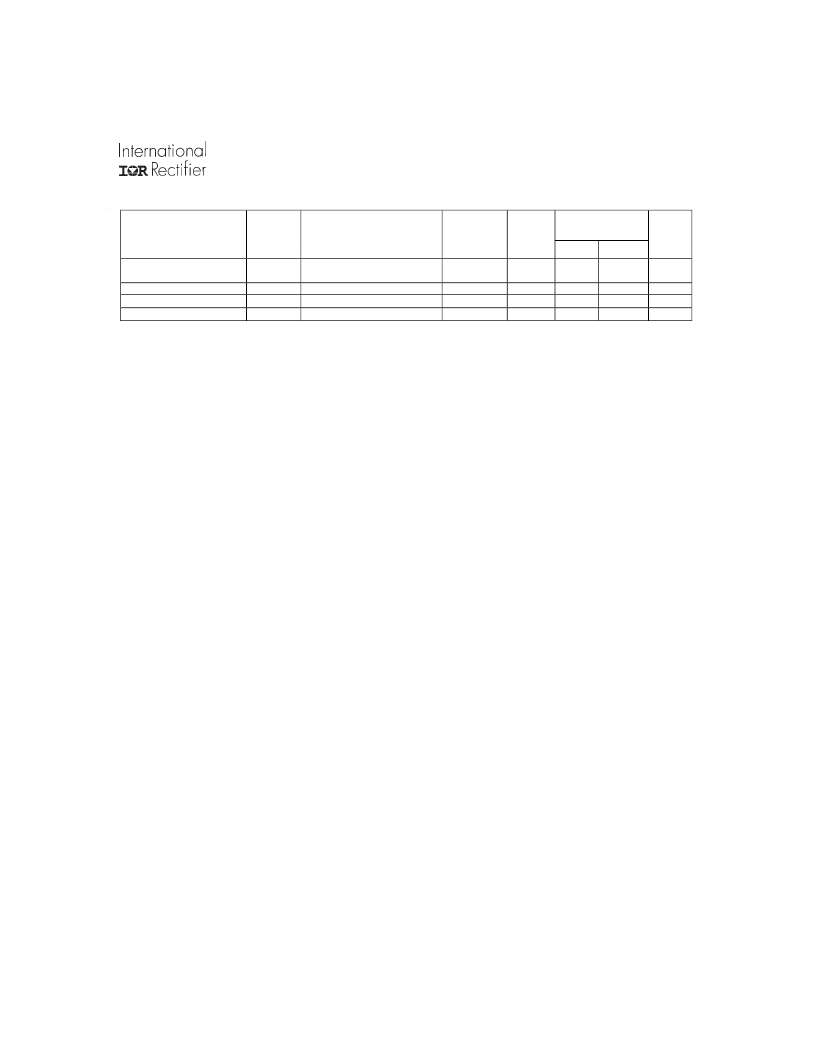- 您現(xiàn)在的位置:買賣IC網(wǎng) > PDF目錄378408 > ATR28XXS (International Rectifier) HYBRID-HIGH RELIABILITY DC/DC CONVERTERS PDF資料下載
參數(shù)資料
| 型號(hào): | ATR28XXS |
| 廠商: | International Rectifier |
| 英文描述: | HYBRID-HIGH RELIABILITY DC/DC CONVERTERS |
| 中文描述: | 混雜高度可靠的DC / DC轉(zhuǎn)換器 |
| 文件頁(yè)數(shù): | 7/12頁(yè) |
| 文件大小: | 97K |
| 代理商: | ATR28XXS |

www.irf.com
7
ATR28XXS Series
Table III. Electrical performance Characteristics -
continued
ATR2812S
Limits
Test
Symbol
Conditions
-55
°
C
≤
TC
≤
+125
°
C
V
= 28VDC
±
5%, C
= 0
Unless otherwise specified
Input step 16V to/from
40VDC, I
OUT
= 2500mA
I
OUT
=0 and 2500mA
I
OUT
=0 and 2500mA
Group A
Subgroups
Device
Types
Max
Units
Recovery time transient
step line changes
Turn on overshoot
Turn on delay
Load fault recovery
TT
LINE
4,5,6
01
10
ms
VTon
OS
Ton
D
Tr
LF
4,5,6
4,5,6
4,5,6
01
01
01
800
25
25
mV pk
ms
ms
10
5, 10
Notes to Specifications
1 Parameter guaranteed by line and load regulation tests.
2 Bandwidth guaranteed by design. Tested for 20 KHz to 2 MHz.
3 Output voltage measured at load with remote sense leads connected across load.
4 Capacitive load may be any value from 0 to the maximum limit without compromising dc performance. A capacitive load in excess of
the maximum limit will not disturb loop stability but may interfere with the operation of the load fault detection circuitry, appearing
as a short circuit during turn on.
5 Parameter shall be tested as part of design characterization and after design or process changes. Thereafter parameters shall be
guaranteed to the limits specified in table III.
6 An overload is that condition with a load in excess of the rated load but less than that necessary to trigger the short circuit
protection and is the condition of maximum power dissipation.
7 Load step transition time between 2 and 10 microseconds.
8 Recovery time is measured from the initiation of the transient to where V
OUT
has returned to within ±1 percent of V
OUT
at 50 percent
load.
9 Input step transition time between 2 and 10 microseconds.
10 Turn on delay time measurement is for either a step application of power at the input or the removal of a ground signal from the
inhibit pin
(pin 2) while power is applied to the input.
相關(guān)PDF資料 |
PDF描述 |
|---|---|
| ATTM01 | Processor Thermal Monitor |
| ATTM01G | Processor Thermal Monitor |
| ATTM01M | Processor Thermal Monitor |
| ATTM01MG | Processor Thermal Monitor |
| ATTM02 | Processor Thermal Monitor |
相關(guān)代理商/技術(shù)參數(shù) |
參數(shù)描述 |
|---|---|
| ATR28XXS_07 | 制造商:IRF 制造商全稱:International Rectifier 功能描述:HYBRID-HIGH RELIABILITY DC/DC CONVERTER |
| ATR28XXT | 制造商:IRF 制造商全稱:International Rectifier 功能描述:HYBRID-HIGH RELIABILITY DC/DC CONVERTER |
| ATR30 | 制造商:Audio Technica 功能描述:Professional Microphone |
| ATR-30 | 功能描述:FUSE MICRO II BLADE 2 LEG 30 AMP 制造商:eaton 系列:* 零件狀態(tài):有效 標(biāo)準(zhǔn)包裝:5 |
| ATR3350 | 制造商:Audio Technica 功能描述:Lavalier Microphone |
發(fā)布緊急采購(gòu),3分鐘左右您將得到回復(fù)。